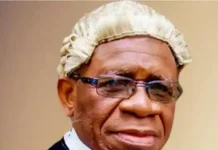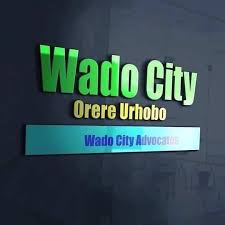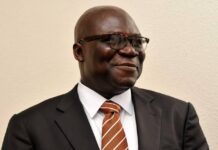What Is Wado City All you should know about the New Urhobo Identity
What is WADO City?
Wado City is the new name adopted by Urhobo people in Warri to identify Urhobo lands in what was then known generally as Warri.
Over the years, Urhobos in Warri have clashed with the Itsekiris over land ownership and tribal identity. It was believed that the name Warri belongs to the Itsekiris as it was a derivative from an Itsekiri word ‘Iwere’.
Pay Attention to Olu Ginuwa: The Untold story of a Disowned Son of Oba Olua of Benin Kingdom
With the Itsekiris claiming the name Warri, a name that has a cover over many tribes, the fear is that it may subjugate other tribes under the Itsekiris, hence the need to rename lands and tribes in accordance with their identity rather than bearing a name that subjugate a tribe under another.
The renaming did not take a crisis tone since it a an awakening in the consciousness of a people who saw the need to take their pride of place in the scheme of things.
Why WADO City?
The Need for the Wado City was as a result of unending cold war between tribes in Warri, majorly Itsekiris, Orhobo and Ijaws. To understand why WADO City was established, let us go back to the root cause of the WARRI crisis whch is till date, a major reason for division..
The Warri crises started as far back as the Awolowo administration under the Acton Group Crisis when the Itsekiri voted massively for the administration, whereas, the Urhobos did not. This made them get Awolowo’s attention to approve the name the Olu of Warri. This sparked the first Warri crises.
Breaking: Google Officially Rename Parts of Warri to WADO City As Urhobo Sons And Daughters Push Harder
The second crises started when the then government relocated the Ijaw local government from Ogbe-Ijoh to Ogidigben. The Ijaws wanted to prove to the world that they also have a stake in Warri, fought hard for and by 1996 succeeded in having a local government council created called Warri South west local Government, with the headquarters in an Ijaw enclave called Ogbe-Ijoh.
You Are Reading What Is Wado City
This angered the Itsekiris, because they felt such a move was a stint on their Overlordship over the name and area called Warri. So once again, they manipulated the Govt, and within 2 weeks the Govt, relocated the new headquarters from Ogbe-Ijoh to Ogidigben an itsekiri enclave.
This move angered the Ijaws to their soul and declared War on the Itsekiri people. They killed, burnt and annihilated many itsekiri villages using Guerrilla tactics. This was the origin of the Second Warri Crisis.
Since the Itsekiris have continued to exercise overlordship over the Warri, a name that covers both Urhobos and Ijaws, the Urhobo have decided to rename their territories to reflect their identities.
Root Cause of the Warri Crisis
By: Dr. Ejiro Imuere
1) Before 1952, Warri city had no history of any crisis, this was because, it was a heterogeneous city built by the British with no Overlord….3 tribes were living together Peacefully, each of them knew their defined borders and territory…. There was no Olu, no Orosuen, no Pere and no Ovie.
2) The Original Place called Warri by the Europeans was Ode itsekiri, ..The itsekiris never called it Warri,….it was the Europeans that gave it that name,….Just like the Yorubas called their city Eko,but the Europeans called it Lagos.
You Are Reading What Is Wado City
3) Now these European established a Govt, in Ode itsekiri in 1891, and called it Warri Govt, and from there they started their Colony,…. So why Lagos became a British Govt in 1861, Warri (Ode itsekiri) became a British Colony in 1891.
” alt=”” aria-hidden=”true” />

Wado City
4) But by 1905, the British realized that Ode itsekiri (Warri was too small a town to be the Capital of the area they intend to Govern, so they needed to move that capital to the hinterland.
5) So by 1908, they engaged Chief Dore to go to Agbassa Urhobo lands in the Present GRA of Warri city to Lease lands to built a New Warri city as a Capital city for this new Govt.
6) So they moved the Warri Govt from Ode itsekiri to Agbassa and environs, now instead of naming the New Capital Agbassa, they retained their name for Ode itsekiri (Warri ) for Agbassa lands.
This was because their Chief Political agent Chief Dore Numa had told them that Agbassa, Igbudu, Okere, Sapele, Oghara, were all Olu land before the interregnum of the Ode itsekiri dynasty of 1848.
You Are Reading What Is Wado City
7) But by 1936, the British had understood the terrain very well,so when they crowned the Only again after 88 years, they refused to crown him as Olu of Warri, but they crowned him as Olu of Itsekiri and in Ode itsekiri.
8) But the Olu wants to move his capital to the new Warri city, then change his title to the Olu of Warri and so be the Overlord of this new heterogeneous City.
9)The British who clearly understood the complexity of the situation refused his incessant requests.
10) But following the Richards Constitution, in the Mid 40’s Power was handed over to the regional Government and the Warri Province fell under the Western region
11) The itsekiris voted Massively for the Action group of Awolowo which headed the Govt of Western region…. The urhobos voted against.
You Are Reading What Is Wado City
15) And with our kind of vengeance Politics which Persist till today, the Itsekiris were handsomely rewarded, by moving the Olu from Ode Itsekiri to the New Warri city.
16) This sparked off the first Warri Crisis that affected many parts of the Warri Province and many Itsekiris were expelled from Urhobo lands.
17) From then on the Olu and the Itsekiris have been trying hard to assert their Authority and Overlordship over Warri city, while the Urhobos and the Ijaws have been fighting hard to resist it.
18) The itsekiris made a strategic move by defining the term Warri to be synonymous with their own tribe itsekiri…. So the word Warri means Iwere or Itsekiri….. Yet they do not even want to hear the Title “Olu of Iwere or Olu of Itsekiri”….. They Prefer the Foreign based one Olu of Warri.
19) But this calculated move is destroying the identities of the other 2 tribes the Urhobos and Ijaws also found in Warri.
You Are Reading What Is Wado City
20) The Ijaws, fought hard and got approval to set up their own kings in their areas, that were added to the name Warri….These kings are known as Pere. E.g The Pere of Gbaramatu Warri kingdom.
21) The Ijaws wanted to prove to the world that they also have a stake in Warri, fought hard for and by 1996 succeeded in having a local government council created called Warri South west local Government, with the headquarters in an Ijaw enclave called Ogbe-Ijoh.
22) This angered the Itsekiris, because they felt such a move was a stint on their Overlordship over the name and area called Warri.
23) So once again, they manipulated the Govt, and within 2 weeks the Govt, relocated the new headquarters from Ogbe-Ijoh to Ogidigben an itsekiri enclave.
24) This move angered the Ijaws to their soul and declared War on the Itsekiri people. They killed, burnt and annihilated many itsekiri villages using Guerrilla tactics. This was the origin of the Second Warri Crisis.
You Are Reading What Is Wado City
25) Not being able to wreak a recompense vengeance on the Ijaws, because they were a Guerrilla warriors, the Itsekiris directed their frustrations on the Okere Urhobos, who had earlier defeated the itsekiris in court and removed their lands from the Overlord of the Olu…..Many Okere Urhobo Houses were destroyed.
26) The Ijaws continued to attack the Itsekiris until 1999, when James Ibori from Urhobo father and itsekiri mother, became Governor and fearing that more will be killed moved the capital of that Local council back to Ogbe-ijoh. And once that Injustice became corrected, Peace was restored.
27) And now an Urhobo son from the Okumagba family of Warri city has been appointed MD of the NDDC, the Itsekiris once again have been crying foul play, threatening war, because once the name Warri was mentioned, the appointment ought to be for the itsekiri.
28) So we now understand that the tendency for a particular tribe to Lord it over others in a Particular territory in an attempt to take all over Government allocation and resources is the root cause of the Warri crisis.
Where Does the Itsekiri of Warri Originated From?
The Itsekiris are not aboriginal to the western Niger Delta. This is according to none other than the foremost Itsekiri historian, William Moore, in his book, History of the Itsekiri. According to Moore, the Itsekiri Nation evolved from transient Yoruba-speaking fishing communities who were allegedly consolidated into a distinct nationality by a fugitive Bini Prince, Iginuwa.
Whereas the pre-histories of the Ijaw, Isoko, Urhobo, Ukwuani and Aboh can be said to be immemorial, events of Itsekiri history are largely memorial. Further credence is given this by Moore on page 13 of his book,
You Are Reading What Is Wado City
“That prior to the advent of the Bini Prince Ginuwa, the territory now known as the Kingdom of Itsekiri or Iwere, was inhabited by three tribes, namely Ijaws, Sobos, and the Mahins. They [Sobos] occupied the hinterland, while the Ijaw occupied the coastline, and the Mahin squatted on the sea-shore near the Benin River.”
A most instructive insight into the indigenous people of the western Niger Delta is that offered by a Portuguese traveller, Duarte Pacheco Pereira. By Pereira’s account written between 1502-1505 after his exploration of the West African Coast, in 1502:
If the Urhobo were already in ground before the advent of Ginuwa then it is illogical that they will have to seek permission from his successors to dwell on their lands.
BRITISH RULE IN THE WESTERN NIGER DELTA
The British government (under the auspices of the Niger Coast Protectorate) assumed control of the trading areas of the Royal Niger Company in 1891 through which various indigenous African communities were made to sign treaties of protection with the British either willingly or by coercion.
Before this date, there was no town known as ‘WARRI’ located in the present Warri City. The present location of Warri City was largely inhabited by the Urhobo clans of Agbarha, Edjeba, Ogunu, Igbudu, etc whilst the riverine side was occupied by the Ogbe-Ijohs (Ijaw).
These were the people the British met on ground and signed treaties of protection with. There was no town called Warri as we have today. The Itsekiri on the other hand, were largely in and around the Benin River and Ode-Itsekiri (their ancestral capital).
The British met the three ethnic groups separate and independent of each other with well demarcated boundaries with none under the other’s subjugation. Thus they signed separate treaties of protection with each group.
You Are Reading What Is Wado City
Consul Hewett, in his treaty signing trip across the Western Niger Delta, in late 1880s and early 1890s, secured many treaties of protection, including four from various Urhobo communities in Warri and two from the Itsekiri. The treaties clearly recognized the ownership rights of land occupied by the Urhobo communities whose leaders entered into agreement with the British.
The treaties also established that the British had consistently identified the Itsekiri geographically as people of Benin River, in much the same way as Nana Olomu and his predecessors in office, were known as Governors of Benin River.
Perhaps, it is worthwhile to indicate the locations where the various treaties were signed. The treaties with Itsekiri (which was earlier in time) were signed in two places, the first on board H.B.M.S. ‘Flirt’ anchored in Benin River on July 16, 1884, and the other at ‘Benin’ on August 2, 1894 on board HM ‘Alecto’.
You Are Reading What Is Wado City
The treaties with the various Urhobo communities, namely:
Treaty with Edjeba, March 7, 1893
Treaty with Agbassa (Agbarha), March 14, 1893
Treaty with Ogunu, March 30, 1893
were signed in the present location of Warri City. Armed with these treaties and those negotiated by the Royal Niger Company, Britain continued with its international bargaining that was taking place in Europe after 1884 for trading rights in Africa.
The treaties provided the basis for the British claim that the Niger Delta area lay within her sphere of influence. They also enabled the British to proclaim after the Berlin Conference, that it had established what it called the Oil Rivers Protectorate.
Against the back drop of the said treaty with Agbarha Chiefs, on 16 April, 1894 a civil servant Custom Officer under the British administration, Saturino Perigrino Wilkey leased land in an area to be known after 1908 as Alders Town or Daudu or Wilkie Town, from Chief Igbi of Agbarha).
The Agreement was witnessed by Lionel Holt for Acting Vice Consul and R. A. Alder. In 1905 Wilkey registered his title 12 years after when the Warri Land Registry was established as “No. 25 of 1905 and is engrossed on page 240 and 241 Register of Deeds Volume 3″ by J. C. During, Registrar of Deeds. One of the witnesses of the Deed was “R. A. Alders, Interpreter to Her Britannic Majesty’s Vice Consulate, Warri”.
You Are Reading What Is Wado City
One interesting aspect of the treaties with the Itsekiri is the omission of the word King which presupposes that the King of Itsekiri has no legal standing in these treaties. This is not a matter of a careless omission. On the contrary, in the 1884 Treaty the word “King” was deliberately deleted from the printed form of the Treaty.
This was so because in 1884, kingship was dead among the Itsekiri. It was a matter whose discussion was forbidden among the members of the Itsekiri merchant aristocracy who usurped royal powers. The 1894 version of the Treaty was handwritten and it updated the 1884 Treaty.
In this latter edition of the Treaty, the King of Itsekiri was totally omitted. Second, the 1884 Treaty specified the territories of the Itsekiri. What was specified originally when the Treaty was signed on July 16, 1884, was “River Benin.”
But there was an addendum dated August 6, 1884, that extended the authority of the Treaty to “the people and country of both banks of the Escravos River, the Chiefs of which have …acknowledged themselves and their country to be under Jakri jurisdiction and authority.”
You Are Reading What Is Wado City
In other words, the British signatories verified with the Chiefs of Ugborodo and other communities in Escravos River that they accepted the terms of the Treaty as applying to them as part of Itsekiri people and lands.
This verification took twenty-one days to accomplish. This goes to show that there was a deliberate verification of Itsekiri territories before the treaty was signed and this did not include Warri City. The Itsekiri aristocracy would not have omitted the inclusion of Warri lands if same were part of Itsekiri possession at the time the said treaties were signed.
Who Owns Warri Lands?
There’s this back and forth between the Urhobo and Itsekiri in regards to the “ownership” of Warri. It may surprise many to know that Itsekiri’s claim actually extends beyond Warri or Sapele.
Actually the Itsekiri’s overlordship claim is over the whole of Urhobolands. They claim that the Urhobo don’t exist as their boundary is with Benin or alternatively, that the Urhobo are Itsekiri slaves who live within Itsekiriland and so cannot own land.
You Are Reading What Is Wado City
The Itsekiri actually caused a publication to this effect in a national daily in 1934. In arguing for the revival of Itsekiri kingship, which had been defunct since 1848, the Itsekiri made a publication in the Daily Times of 13th June 1934 where they employed the use of a defamatory epithet on the Urhobo.
The article contained a number of statements which the Urhobo regarded as objectionable and defamatory. For example, the article referred to Chief Dogho (Dore Numa) as ‘the recognized Ruler of the Itsekiris and Sobos’. It further stated that within the borders of Itsekiriland ‘lived the Sobos, a hardy people, who served for several years in the capacity of slaves to their Itsekiri and Benin Masters’.
‘Within a comparatively few years of their emancipation,’ the article went on, the Urhobo had made outstanding progress in the affairs of Native Administration, so much so that the Itsekiri had been forced by that fact to seek the installation of an Olu so that they too could have a properly organized Native Administration.
You Are Reading What Is Wado City
The British authorities were of course displeased with this publication and put pressure on the Itsekiri Native Authority which duly entered a disclaimer with an apology to the Urhobo people for the wanton unprovoked attack from the Itsekiri.
Of course the apology is nothing other than just deferring to the British authority as the Itsekiri holds on tenaciously to the belief that they are a superior people and were civilized by contact with Europeans long before their “backward” neighbours of the hinterlands. Under this notion, the Itsekiri feel entitled to be the overlords of not only the Urhobo but the Ijaw, Isoko, Kwale and Aboh who were all under the old colonial Warri Province.
You Are Reading What Is Wado City
In other words, it’s not like the Europeans arrived to meet a thriving Itsekiri Kingdom or Empire subjugating its neighbours and dominating them rather it is a claim based on a notion of superiority anchored on British colonial rule which by purely accidental circumstances an Itsekiri man, Dore Numa, rose to prominence and enjoyed some privileges on being appointed a political agent as reward for his role in betraying Nana Olomu and helping in facilitating the sacking of Oba Ovoranmwen of Benin.
With this mindset, peace will continue to elude Warri and it’s environs for long to come.
THE CHANGE OF THE TITLE “OLU ITSEKIRI” TO “OLU OF WARRI”
By T. E. A SALUBI
Quite recently, without consulting their neighbouring tribes, the mixed community of Warri Township, the Itsekiri people, with the approval of the present government of the Western Region have changed the title of their ruling head from the Olu Itsekiri to the Olu of Warri.
The announcement of the change was made through the local radio service in Warri Township and since then, the Urhobo people have strongly protested against the change to the government through the Resident of the Province.
You Are Reading What Is Wado City
It would appear from all events that the present Olu, Erejuwa II, is out to break historical records and to create new ones. In spite of the fact that Ode Itsekiri had been the revered seat, and therefore, the headquarters of all the seventeen Olus that reigned before him, Erejuwa II, moved his seat to a small village called Ekurode a few miles from Warri Township by Okere.
There he must build a palace. Now he has thrown overboard the time-honoured title of his fathers. In a way, we are in a great sympathy with the Olu. Left alone, he would no doubt prefer to maintain the honorary traditions of his royal ancestors, but being what he is in the hands of certain Itsekiri young men, he must dance to their tune instead of the other way round.
All this, of course, is the business of the Itsekiri people, and it must remain so except where any change affects directly or indirectly the interest of other tribal groups in Warri Province. The Urhobo people say and maintain without prevarication that the change of the Olu’s title is inimical to them; they have therefore protested and will ever protest against it.
You Are Reading What Is Wado City
We own the onus to adduce reasons for our protest but before doing so however, we consider it necessary to say a few words, perhaps in an historical way, about the Olu, Itsekiri people and their original home.
In the course of this we shall also touch on their commercial activities with early European traders, and how from that source the British government extended its administration to Urhobo land.
Finally, we shall conclude with an attempt to give our readers the true perspective, politically, of the position of the Itsekiris vis-à-vis their Urhobo neighbours. And we hope that by the time we finish, our reasons for the objection will be so clear as not to require further elucidation.
THE TITLE OLU ITSEKIRI
According to some historians and writers, the Itsekiri Kingdom was founded by Iginua, the son of Olua, an Oba of Benin who reigned from about 1473 to 1480. Olua invested Iginua with the title ODIHI-NA-ME (meaning the depth of water) but the Itsekiri cailed him “OLU ITSEKIRI”.
That has in fact been the title from the beginning of the Kingdom up till the time of Olu Akengbuwa who died on the 14th of June, 1848. Akengbuwa’s death was however followed by a great lasting confusion in Itsekiri-land.
His son who should succeed him on the throne died suddenly miraculously on the 18th of June, 1848, four days after the father’s, and the next son also died in quick succession thereafter. A riot ensued and no Olu was installed until February, 1936, when Giriuwa II ascended the Itsekiri throne. Thus there was an interregnum of some 88 years.
Ginuwa II died on the 8th of January, 1949, and was succeeded in March, 1951, by the present Olu, Erejuwa II.
THE ITSEKIRI PEOPLE
According to William Moore, an Itsekiri man, the Olu called Ijijen drifted to a town the inhabitants of which were called “ITSEKIRI”. The people had been variously referred to by Europeans from the early days of coastal trade as SHAKRI, ZAKRI, ZEKRI, DZEKRI, IZEKRI, ISHEKIRI, TCHEKRE, JAKRY, JAKRI, JEKERI and JEKRI, the last four being the most recently anglicised forms.
You Are Reading What Is Wado City
The people’s true origin appears to be uncertain, but according to popular legends, they came from the Yoruba country. Talbot believed that they were Ekiti Yorubas who came there through Benin.
Others thought that they were coastal Ijebus or Mahins who travelled the coast farther down south for habitation. In any case, the relevant point here is that a people known as Itsekiri accepted an Oba who found his way to them as their Olu, hence the title OLU ITSEKIRI.
ODE ITSEKIRI (WARRI)
The town in which the Olu found the people had been known as “ODE ITSEKIRI” (capital of Itsekiri) and it had until the reign of the present Olu been the seat of the Olus.
This town had long been associated with a name similar to the present anglicised name “WARRI”. “IWERRE” or “IWERRI” was the name by which the Binins called the Itsekiri people.
The name had been spelt and pronounced variously by different early European missionaries, explorers and traders who came in contact with the town from as far back as the 16th century.
Between 1651 and about 1668, according to URBANUS CERRI, the town was referred to as “ANWERRE” and according to Roth it was “AUWERRE”.
Dr. Dapper called it “OWWERRE”, while in about 1682, Father Jerome Merolla da Sorrento writing about two Catholic Priests who went there in 1682 referred to it as the Kingdom of “OUUERRI”.
David Van Nyendael, a Dutchman, writing from on board the Yacht “JOHANNA MARIA” on 1st September, 1702, called it “AWERRI” while John Barbot called it variously indiscriminately as “DOWERE”, “AWERRI”, “OUWERRI”, “OVEIRO” and “FORCADOS”. It has variously been referred to also as OWERE, OWIHERE, AWERRE, WARRE, and QUARRE.
From about 1789 to 1857, others like Adams, Boteler, John Beecroft, Commander Tudor of H.B.M.St.Vepel “FIREFLY” and Consul Campbell of Lagos, all referred to Ode Itsekiri as “WARRE” or “WARREE” and as comparatively recently as 1934, Mr. Jacob Egharevba of Benin in his book referred to it as “OWHERE”.
Apparently the present anglicised form “WARRI” was coined from WARRE or WARREE.
You Are Reading What Is Wado City
Ode Itsekiri was probably a town of some respectable size. In about 1668 according to Roth, the inhabitants were about 3,000 but in about 1789, Dr. Dapper estimated them to be about 5,000. By the standard of those days that population may be regarded as large.
However with the death of Olu Akengbuwa and the unfortunate incidents that followed, a great exodus ensued and the town started to fall into ruins. The position deteriorated progressively until the town lost whatever greatness it had.
The following account of Commander R.G. Craigie, then the Senior Naval Officer of the Admiralty in the Bights of Benin and Biafra, who visited the town in August 1884 with Consul Hewett, Chief Nana and Chief Chanomi confirmed this.
Commander Craigie observed “The town of Warri is a mere shadow of its former greatness, the broad streets being overgrown with lime trees and bush, and many of the clay houses in ruins; formerly five English firms had factories there, but all removed to Benin River in 1873”.
To most Itsekiris, the town is a sacred place for the burial of their dead and the offer to ancestral spirits of annual sacrifices. In 1890, Sir Alfred Moloney, one of the earliest Governors of Lagos, made the following observation: “Jakry men have a great veneration for Warre.
The corpses of ‘big men’ are taken there for burial after death; while in the case of ‘small men‘ only the hair and toe and finger nails are taken there”.
T. E. A. SALUBI (5th September 1952)













